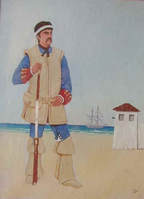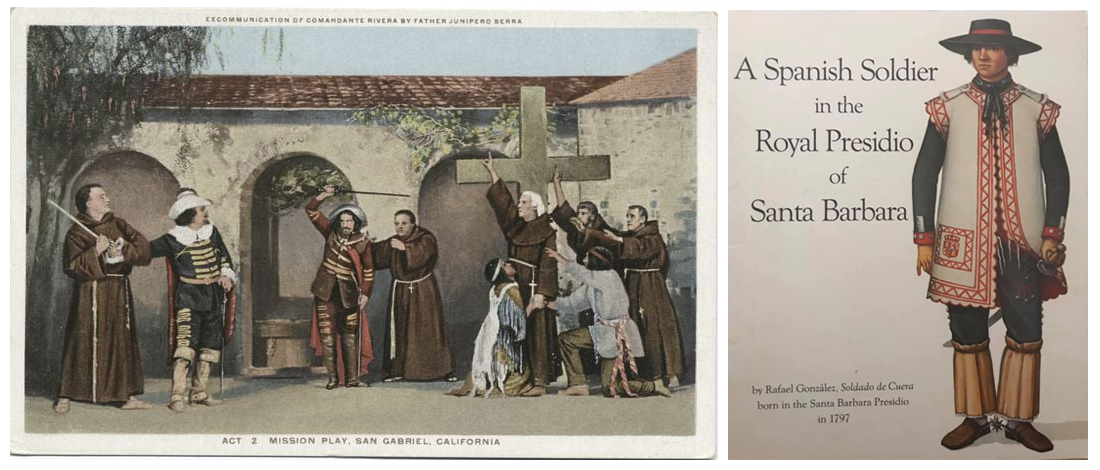
 Painting of El Soldado de Cuera
Painting of El Soldado de Cuera
by Dr. Jack S. Williams
Los Soldados de Cuera
Quote from Costansó

The Soldiers of the Californias Presidio, of whom equity and fairness require us to own that they labored endlessly in this Expedition, employ two kinds of arms, offensive and defensive: The defensive ones are Buffcoat and targe; the first of these, whose cut is similar to a sleeveless Coat, is made of six or seven plies of white worked deerskin, impenetrable to Indian arrows unless shot from very nearby. The targe consists of two facings [s] of rawhide, it is managed with the left arm, and they use it to deflect arrows (“jars” as they call them), the horseman thus defending himself and his mount. They employ besides these, a sort of apron of cow-hide leather pinned to the head of the saddle and falling down on both sides, that they call “armas” or defensas, covering their legs and thighs so as to keep them from injury when galloping through the brush. Their offensive weapons are the lance, which they handle deftly a [on] horseback, the broadsword, and a short musket which they carry put up and fastened in a sheath. They are men of great hardiness and endurance in their work; quick to obey, determined, nimble, and, we do not scruple to say, the best Horsemen in the world and among those Soldiers who best earn their Bread from that August Monarch whom they serve. Miguel Costansó, Diario Historico, 1769
Letter from Portolá
. . . I regard the uniform worn by the California Buff-Coat Company as extremely useful; our Soldiers [his dragoons] can’t continue to wear the uniform they do now, for our first excursion abroad has just left everyone stripped of it – I more than anyone reached here torn and scratched to pieces by the terrible Thorn-trees [cactus] along these same trails in this Country . . . Certainly, Sir, a man must have more Cowherd than Soldier in him in order to serve in this land . . . México, Archivo General de la Nación, ramo de Californias, t. 76
Costansó and Portolá agreed, together with most other observers, that the soldados de cuera were among the best horsemen in the world. The primary reason was that they were recruited from the ranchos of northern Mexico and later from California and Arizona. They had spent most of their youth on horseback, so learning to be a soldier on horseback was a small step for them.
The soldados de cuera were regular soldiers of the Spanish army, but with a difference, they were mounted, and required to maintain six horses. They were supposed to be paid a regular salary, receive uniforms, arms and housing, and much of their food. In fact, in California, even before 1810, pay and uniforms seldom got this far, the soldiers were frequently described as in rags, and trading uniforms to the Indians for food. Between 1812 and 1822 there was no pay at all. After the success of the revolution, the new government left the maintenance of the California soldiers to the local government, which rapidly reduced the force to an unpaid militia. It is probable that the “soldado de cuera” essentially vanished from California by the 1820s.
The leather jackets, while providing protection from arrows, had a serious defect, they were not rainproof, and in a sudden rainstorm they soaked up water like a sponge, multiplying the weight. They dried slowly, and worse, became stiff. It is fortunate that the southwest was a desert.
The weapons they used were supposed to be musket, pistol, sword, and lance. The musket and pistol were effective only in a cavalry charge against a massed enemy, which as far as is known never happened here. Therefore, the lance and sword, and, a weapon seldom mentioned, the bow and arrow, were the mainstays. The lance was the primary offensive weapon and the soldados de cuera were very skilled in its use. Even as late as 1846, the American army learned of its effectiveness at the Battle of San Pasqual.
The Indian raids on the missions and private ranchos, as well as against friendly Indians for cattle, horses, and young women, had a standard response. Notice was sent to the Presidio, eight or ten soldados would get their six horses and ride at top speed after the raiding Indians. If possible, they would recruit friendly Indians, but the only hope of catching the raiders was to ride at top speed. When one horse gave out, they switched saddle and continued. Hopefully, they would pick up the spent horse on the return. The pursuit continued until either the raiders managed to get far enough into the mountains to escape or the soldados caught up. The battles were usually short, the Indians abandoning part of their loot and escaping with the rest.
Each of the Missions had 5 soldados and a Cabo (Corporal) as guard, occasionally a few more when there was need. Since there were only 55 soldiers per Presidio, after manning the Missions, there were only 25 or so soldiers left at the Presidio. Then a guard was kept at the Presidio horse rancho, soldiers handled all the mail delivery, and acted as escorts. As one soldier expressed it, “I have more duties than the Devil has fallen angels”.
With four Presidios, there were only 220 soldiers in Alta California for most of the Spanish reign; there were estimated to be over 200,000 Indians. With these odds, how did the Spanish prevail? Part of the answer is that there was a considerable support from the local Indian tribes. In fact, at least in the southern part of the state, many Indians were recruited into a militia. At Santa Barbara some 200 Chumash were trained and armed.
Now, where did the soldados de cuera go?
In the main they didn’t go, they stayed, had families, and their descendants are us.
